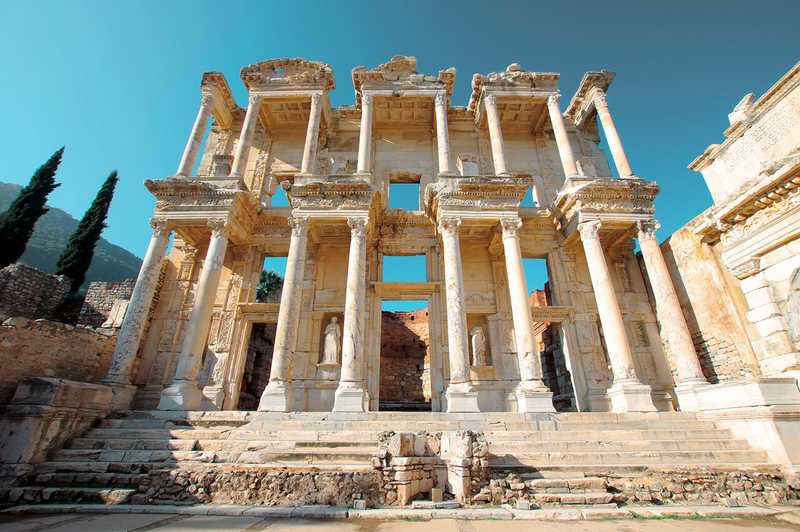Library of Celsus stands on small square at the intersection of the Marble Way and Street of the Curetes, adjacent to the southern entrance of the Tetragonos Agora. It was built on a site excavated after the demolition of a house to the south.
As one of the finest architectural structures in Ephesus, the library underwent lengthy and extensive restoration work beginning in the 1960’s. This was finally completed in 1978, when the building was opened to visitors. The insertion of lead plates beneath the re-erected columns has improved the building’s flexility, allowing movement of up to 50 centimeters and providing resistance of magnitude 9.0. The library a heroon (a monument dedicated to a heroic figure) built over the burial site of Tiberius Celsus Polemaenuis, a one-time Roman governor of Ephesus. His son, Julies Aquila, later commissioned the construction of the monument. Built on two floors, the Library of Celsus was completed in 135 AD, but suffered damage to the reading room from a fire that broke out with the 262 AD earthquake. No moves were made to renovate the reading room, but in Late Antiquity the library’s surviving facade was transformed into the rear wall of a nympheum. A pool was built on the former steps and the original facade decorated with relief plaquets from the Parthian Monument. The Parthian Monument reliefs had been part of a monumental altar dedicated to Emperor Lucius Verus . A 40-meter length of the frieze is on display at the at the Ephesus Museum in Vienna, other sections are held by the Ephesus Museum in Selçuk. Standing 16 meters tall and 21 meters wide, the undamaged facade featured a row of statues between its columns. A flight of nine steps led up to the podium. The pedestals flanking the top steps were probably mounted with statues of cavalrymen.
There were three entrances behind the columns of the facade; the middle these was taller and wider the than the two to the sides. Windows were built on the second floor to match thee style of the doors. The doors were flanked by ornate niches, each containing a statue which were casts of the originals, which were taken to Vienna in 1910. Starting from the left, the first statue depicts wisdom (Sophia), the second virtue (Areta), the third judgement (Ennoia) and the fourth one knowledge (Episteme). The niches on the upper floor must presumably have been filled with bronze statues. Likewise, there was a statue of Celsus in the apsidal niches opposite the large middle door of the building. The side walls of the interior featured wooden galleries. The library’s books were kept in parchment rolls and these were arranged on shelves in rows of rectangular niches built into the walls. A second, external wall was built behind the inside wall with an airspace in between to protect the books from environmental damage (humidity etc). Lying beneath the central the central apse is the sarcaphagus of Celsus, decorated with depictions of Eros. An inscription found on the sarcophagus provides enlightening details about his life: originally from Sardis, Celsus worked at various important public institutions in Rome, before being made consul in 92 AD and proconsul (governor) in 106 AD.

